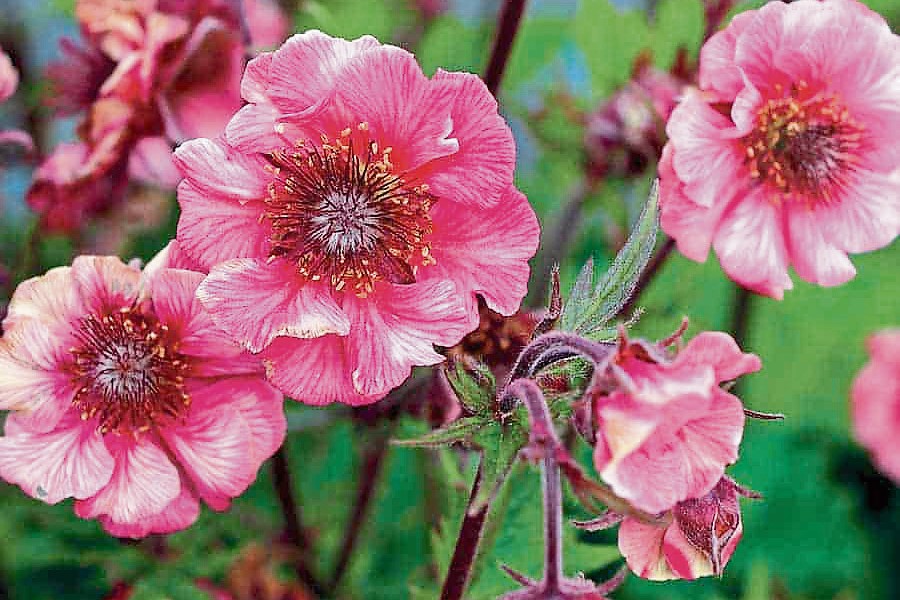APRIL is upon us, hopefully bringing us a touch of dry, warm weather, something we haven’t seen in a very long time.
As I previously mentioned in last month’s article perennials are by far one of my favourite plants in the garden due to their importance in the biodiversity.
First, we need to discuss what perennials are. Perennials are usually small, cold-hardy plants that die down or are cut back in winter, which will then come back to life again the following spring, usually bigger and better than before as they gain strength with maturity. They are a very hardy and versatile plant that suits most gardens in our local area.
You can plant a range of perennials to flower in spring, summer and/or autumn so you get colour for most of the year. They’re available in many shapes and sizes, with flowers in every colour imaginable, and when planted in borders or containers they can perform for many years.
Perennials are brilliant plants to use as pollinators. When using a plant, such as a perennial as a pollinator, you’re hoping to attract bees, butterflies, and other insects to your garden. Pollinators are very important to your Garden as it allows plants to fruit, set seed and breed, which is very important for biodiversity.
When working with such a massive variety of perennials every day like I do, it can sometimes be hard to choose one favourite, so I’m going to quickly discuss my top five favourites this week, because it’s always changing! My top five this week would have to be Aubrieta, Arabis, Geum, Heuchera and Erysimum.
Starting with Aubrieta, which belongs to the Brassicaceae family and has a genus that includes about 15 species. Aubrietia is used predominantly in rockeries, and as ground covers. As groundcover, Aubrieta are creeping cushion perennials with a low growth habit, reaching a maximum height of 15 inches. With their growth habit they form wide and dense mats that will give a carpet of colour. It flowers between April to June, colours varying from most commonly blue, white, pink or red. Aubrieta provides a rich source of nectar for bees, various butterflies and numerous other pollinators. As a frugal perennial, Aubrieta requires little care. To keep this cushioning perennial nice and compact, it is recommended to cut back the Aubrieta by about half its size each year after flowering in May/June. This prevents seed formation and compacts the cushion.
Arabis commonly known as rockcress is also Brassicaceae family. Arabis is a beautiful dwarf growing rockery plant which is very compact in size. Perfect as ground cover, for rockeries or along edges. It bears a profusion of large flowers from April to July and reaches an approximate height of 15cm. Colours varying from white, pink or purple. Arabis can be cared for very easily as it’s known as a low maintenance perennial. Simply cutting it back by half its growth will further encourage new growth and help to thicken it out.
Geum part of the Rosaceae family, with a genus which includes 54 varieties. My favourite would have to be the ‘Tempo Rose’ which produces a profusion of single and double rose-pink flowers from April to July. Several single and double blooms are held up on each wiry stem above pretty mounds of attractive, weed-suppressing, semi-evergreen foliage for up to six months each year. A good fact that not everyone knows is that Geum are slug, deer and rabbit resistant so you can grow them without the worry they will get eaten. Geum will usually grow no more than 50-60cm in height. They are suitable for most rockeries, flower beds or borders. Geum has attractive seedheads which if left on the plant will last well into winter. In this scenario, a light spring tidy of stems and dead leaves is all that is required.
Heuchera otherwise known as coral bells, is a perennial plant species that belongs to the Saxifrage family. There are over 50 different species of Heuchera. With a wide variety of cultivars, Heuchera offers a diverse range of colours, leaf shape and sizes. Colours range from lime green, to purple, red and pink, and every colour in between. The colour provided by these plants all year round is why people continue to plant them again and again.
Heuchera is loved for its versatility, as it’s compact size and low growing habits make it suitable for borders, beds and even container planting. Most varieties will grow between 20 to 30 centimetres in height and width. One of its best-selling features is the fact that it is a shade loving plant, unlike most other plants it can tolerate varying levels of shade. Just to name a few of my favourite varieties would include ‘Marmalade’, ‘Forever Red’ and ‘City Paris’, however, it truly is hard to choose a favourite when working with so many every day.
Finally this weeks final favourite the Erysimum or as most people know it the Wallflower. This plant has been around since the 16th century, hence why it’s an old-time favourite that is in almost everyone’s garden. It’s a plant most people will remember seeing in their granny or grandad’s garden when they where young, it has to be one of the most nostalgic plants there is. The Erysimum is a perennial plant species that belongs to the Brassicaceae family.
There are over 150 different species of Erysimum. Colours most commonly include yellow, orange, purple and red. Erysimum flower from March to August. Most varieties grow 60 to 80cm in height and 50 to 60cm in width. Erysimum Add fantastic colour to your garden even when they’re not flowering. The best way to extend the lifespan of the wallflower and ensure their kept compact and neat you need to give them a yearly trim after they finish flowering midsummer. Keeping them cut back and maintained ensures that they do not become woody looking.
These are a just a very small snippet of ideas of perennials suitable for you, as the summer progresses, I have no doubt we’ll revisit a few other examples. Now is the perfect time to plant your pollinator plants and encourage a better biodiversity for us all. Perennials are a cost effective way to add great colour to your garden, why not get planting now!
To read more.. Subscribe to current edition
Receive quality journalism wherever you are, on any device. Keep up to date from the comfort of your own home with a digital subscription.
Any time | Any place | Anywhere










